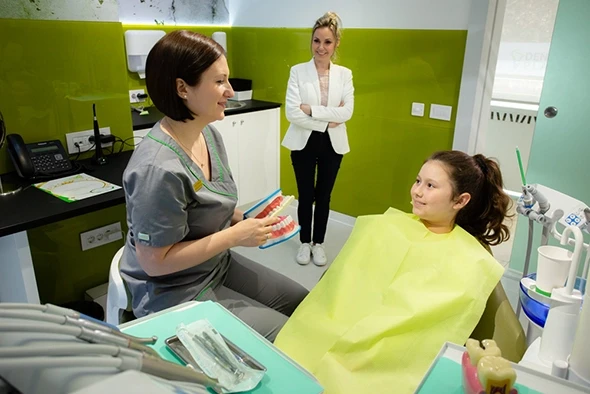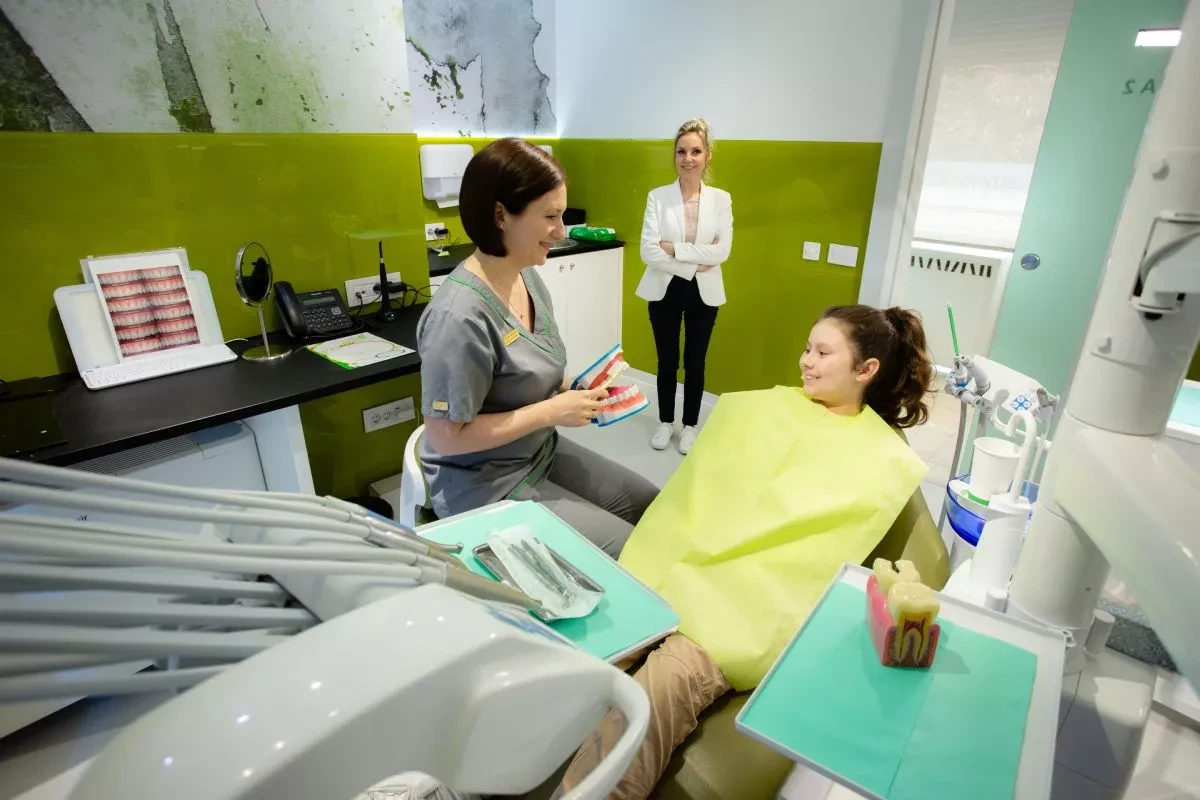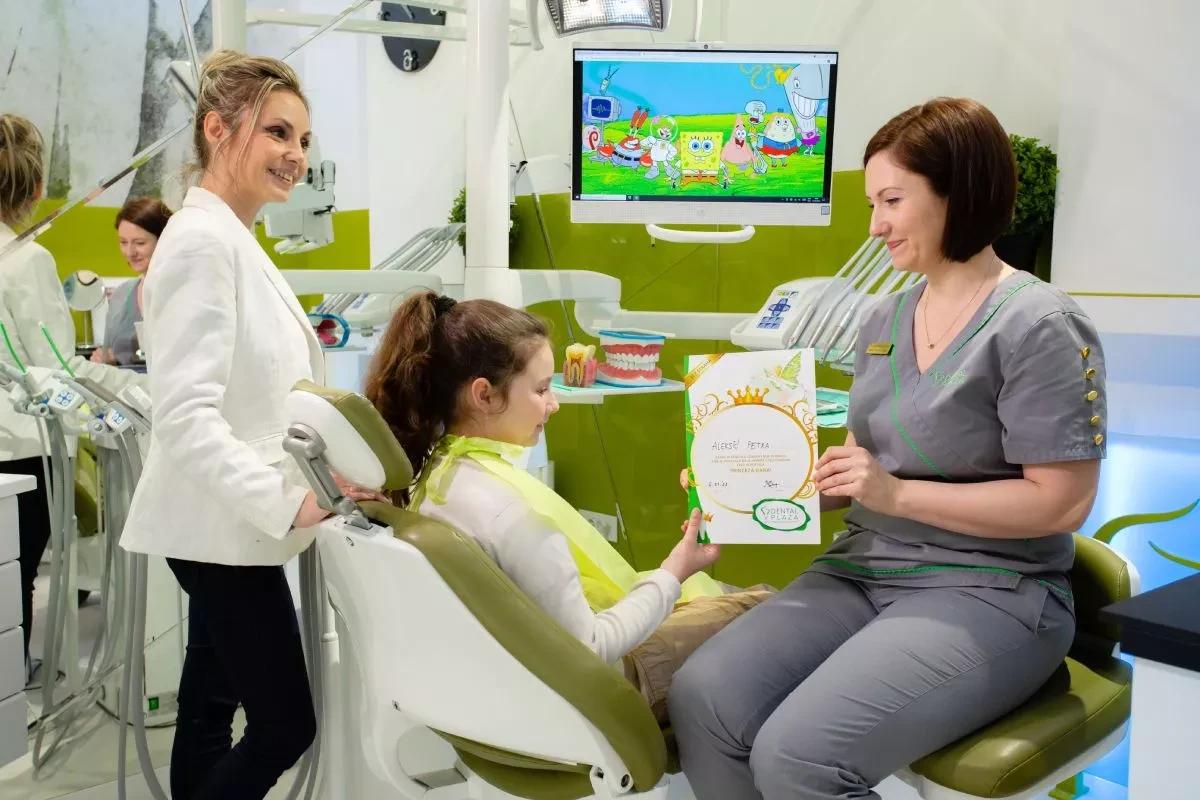Do not be shy, show your teeth!
Call Center 08-21h
Do not be shy, show your teeth!
Call Center 08-21h

Children's dentistry is a branch of dentistry that should be given great importance. The importance of a mandatory dental examination during the first year of a child's life is indescribable. After checking the condition, it is possible to indicate the present risks for the occurrence of caries and proposed measures for their elimination.
Yes, it is important! While the teeth are still healthy, the child will have a pleasant first experience at the dentist, where he will get to know the environment around him and his doctor.
It is very important to bring children at a younger age to the dental clinic for the first time, so that the child's introduction to the new environment and procedures, as well as the entire process of adaptation, will be as easy and pleasant for the child as possible.
Every three months, it is necessary to bring children for check-ups, in order to check the condition and preserve their oral health. Children's dentistry tries to create healthy habits for children, so you should not forget about visits to the dentist.
When it comes to brushing children's teeth, it is very important to start it with the appearance of the first milk tooth. Until the second year, it is sufficient to wash it with a brush and water, unless the dentist judges that it is necessary to include the paste as well.

As a rule, a once-acquired habit remains throughout life, so it is important to teach children how to brush their teeth properly. The easiest way is to explain the washing system to them "how the rain falls and how the grass grows", and to make brushing their teeth more interesting through games and songs. The most important thing is to remove all the remains of food and deposits that are collected near the gums and in the deepest parts of the teeth, i.e. in dimples and in fissures.
Fissure filling is a procedure in which composites of a special composition are applied to the deep spaces on the biting surfaces of the teeth. This prevents retention of food and prevents the occurrence of caries on the lateral teeth. It is recommended that this measure be done at the age of six, immediately after the dentition of the permanent molars.
For a long time, the position of the profession was that only absolutely healthy teeth should be filled. However, in very deep fissures of the teeth, it is very difficult or almost impossible to diagnose the caries, so among dentists there was a fear of filling the teeth. Modern filling materials can stop or at least slow down the initial decay or prevent new caries from developing.
If the dentist judges that the initial defect is due to filling, such a tooth is checked more often. Certainly, the conclusion is that fillings cannot harm the teeth in any way and that they are very useful and effective.
Filling of fissures is a quick procedure and takes about fifteen minutes. It is completely painless and pleasant for children. It is one of the preventive procedures that can help the child feel as comfortable as possible in the dental office.

This procedure is a simple teeth cleaning. It is painless and very suitable for children to get used to the sound of dental instruments, and at the same time to clean their teeth from dental plaque. It is best to use appropriate dental plaque detection tablets before starting. These tablets contain pigments that color the dental plan, so that it is noticeable and visually displayed to children. Brushes and abrasive pastes are used to remove plaque. In this way, children accept further procedures more easily.
In small children, the teeth fluoridation can be performed. With this procedure, high-concentration fluorides are applied directly to the surface of the teeth, which promote tooth remineralization. Locally applied fluorides can prevent the formation of carious lesions or prevent the further development of initial caries. Also, if there is too much sensitivity of the teeth to various stimuli due to thinned enamel, applying remineralization agents creates a protective layer that will prevent unpleasant sensations.

Do you have questions?

Children's dentistry is a branch of dentistry that should be given great importance. The importance of a mandatory dental examination during the first year of a child's life is indescribable. After checking the condition, it is possible to indicate the present risks for the occurrence of caries and proposed measures for their elimination.
Yes, it is important! While the teeth are still healthy, the child will have a pleasant first experience at the dentist, where he will get to know the environment around him and his doctor.
It is very important to bring children at a younger age to the dental clinic for the first time, so that the child's introduction to the new environment and procedures, as well as the entire process of adaptation, will be as easy and pleasant for the child as possible.
Every three months, it is necessary to bring children for check-ups, in order to check the condition and preserve their oral health. Children's dentistry tries to create healthy habits for children, so you should not forget about visits to the dentist.
When it comes to brushing children's teeth, it is very important to start it with the appearance of the first milk tooth. Until the second year, it is sufficient to wash it with a brush and water, unless the dentist judges that it is necessary to include the paste as well.

As a rule, a once-acquired habit remains throughout life, so it is important to teach children how to brush their teeth properly. The easiest way is to explain the washing system to them "how the rain falls and how the grass grows", and to make brushing their teeth more interesting through games and songs. The most important thing is to remove all the remains of food and deposits that are collected near the gums and in the deepest parts of the teeth, i.e. in dimples and in fissures.
Fissure filling is a procedure in which composites of a special composition are applied to the deep spaces on the biting surfaces of the teeth. This prevents retention of food and prevents the occurrence of caries on the lateral teeth. It is recommended that this measure be done at the age of six, immediately after the dentition of the permanent molars.
For a long time, the position of the profession was that only absolutely healthy teeth should be filled. However, in very deep fissures of the teeth, it is very difficult or almost impossible to diagnose the caries, so among dentists there was a fear of filling the teeth. Modern filling materials can stop or at least slow down the initial decay or prevent new caries from developing.
If the dentist judges that the initial defect is due to filling, such a tooth is checked more often. Certainly, the conclusion is that fillings cannot harm the teeth in any way and that they are very useful and effective.
Filling of fissures is a quick procedure and takes about fifteen minutes. It is completely painless and pleasant for children. It is one of the preventive procedures that can help the child feel as comfortable as possible in the dental office.

This procedure is a simple teeth cleaning. It is painless and very suitable for children to get used to the sound of dental instruments, and at the same time to clean their teeth from dental plaque. It is best to use appropriate dental plaque detection tablets before starting. These tablets contain pigments that color the dental plan, so that it is noticeable and visually displayed to children. Brushes and abrasive pastes are used to remove plaque. In this way, children accept further procedures more easily.
In small children, the teeth fluoridation can be performed. With this procedure, high-concentration fluorides are applied directly to the surface of the teeth, which promote tooth remineralization. Locally applied fluorides can prevent the formation of carious lesions or prevent the further development of initial caries. Also, if there is too much sensitivity of the teeth to various stimuli due to thinned enamel, applying remineralization agents creates a protective layer that will prevent unpleasant sensations.
